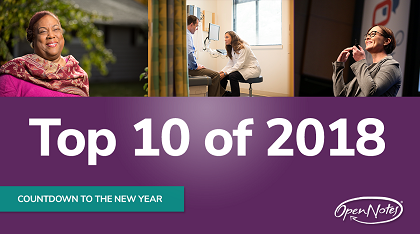
by OpenNotes
It’s been a remarkable year for OpenNotes!
In 2018, the number of health systems sharing notes and the number of patients with access to notes has continued to rise. We’re excited by the momentum OpenNotes is gaining, but there’s still plenty of work ahead.
Here are ten highlights from 2018 that have us energized for the New Year.
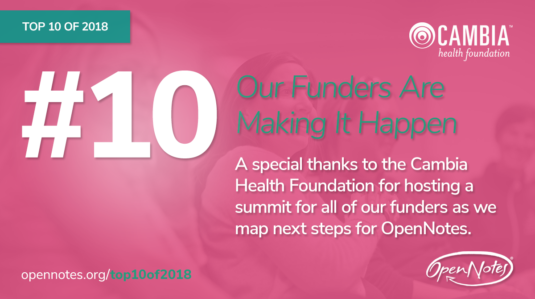 #10: Our funders are making it happen
#10: Our funders are making it happen
Thank you to our supporters who funded the work of OpenNotes throughout the year—Cambia Health Foundation, CRICO Risk Management Foundation, The Commonwealth Fund, Gordon and Betty Moore Foundation, Peterson Center on Healthcare, Robert Wood Johnson Foundation, the Shah Family Foundation, and John F. Keane and his family. Special thanks to Steve Lesky at Cambia Health Foundation who hosted a reception for OpenNotes last month at The Cambia Grove health care innovation hub in Seattle. There, we were able to announce that over 30 million people have access to their clinical notes in North America.
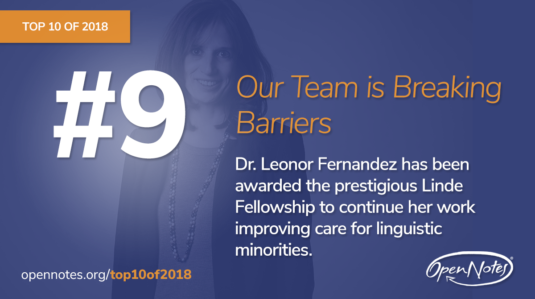 #9: Our team is breaking barriers
#9: Our team is breaking barriers
This July, OpenNotes’ Vulnerable Populations and Health Equity expert, Dr. Leonor Fernandez, was chosen as a recipient of the prestigious BIDMC Linde Fellowship program. Through the generous gift of the Linde Family Foundation, she will explore current care for linguistic minorities and identify key indicators of quality that need attention. She will outline and develop strategies that promote effective and humane care across language barriers for all patients.
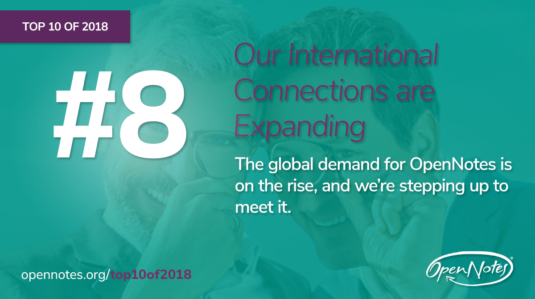 #8: Our international connections are expanding
#8: Our international connections are expanding
Our efforts to spread OpenNotes internationally continue. In October, our senior leaders presented to large audiences in England and Germany. We reconnected with Dr. Tobias Esch, former OpenNotes fellow and author of the book “Die bessere Hälfte” (The Better Half) – the #1 non-fiction bestseller in Germany about an inspiring dialogue between two physicians. Among the topics discussed in the book: experience, maturity, wisdom, and OpenNotes.
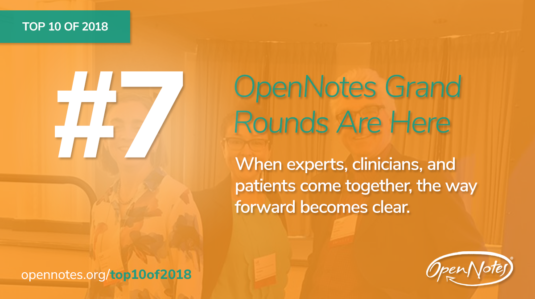 #7: OpenNotes: Grand Rounds are here
#7: OpenNotes: Grand Rounds are here
This year OpenNotes launched a new series of webinars called OpenNotes: Grand Rounds where OpenNotes supporters, health system leaders, patients, and clinicians come together to talk about lessons learned, and opportunities and challenges that come with sharing or reading visit notes. With close to 200 registrants at each webinar, speakers cover topics ranging from OpenNotes basics (What are notes? Why do they matter?) to more complicated subjects like how to measure if patients are actually reading their notes. You can watch our first two Grand Rounds webinars here: OpenNotes 101 and Effective Implementations. [ will link once the video is up]
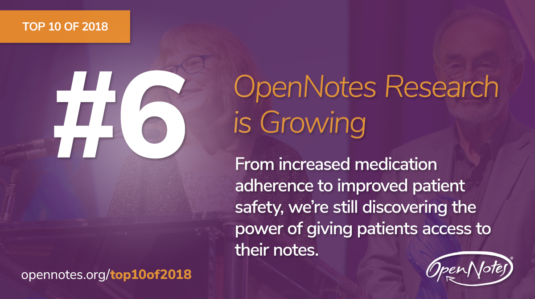 #6: OpenNotes research is growing
#6: OpenNotes research is growing
As the OpenNotes movement spreads, our team, alongside many clinicians and healths system around the world, are investigating how opening notes to patients inspires changes in clinician and patient behavior. Our team published six new papers this year, and our website Research page is updated with the latest. Check them out here.
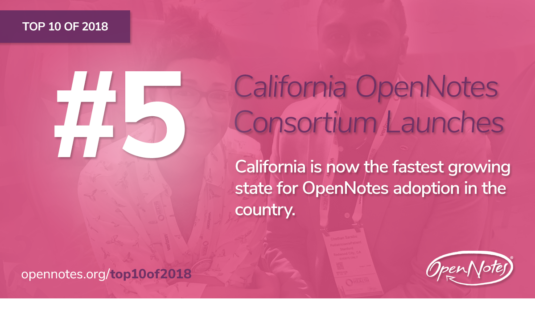 #5: California OpenNotes Consortium is building momentum
#5: California OpenNotes Consortium is building momentum
With 25 organizations sharing clinical notes with patients, California is now the fastest growing state for OpenNotes adoption in the country. New implementers are as diverse as the state; organizations sharing notes include county health systems, FQHCs, major academic medical centers, regional hospitals, and a major children’s hospital. In total, 17 new organizations began sharing notes in 2018. One factor leading to the increased adoption in the state could have something to do with the launch of the California OpenNotes Consortium (CONC), co-chaired by Liz Salmi and Kerry Litman, MD. The California efforts are part of a new research dissemination strategy to develop “networks of networks” to help like-minded organizations to learn from one another. Learn more about the California network here.
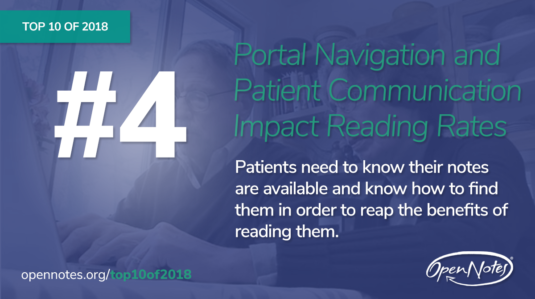 #4: Portal navigation and patient communication impact reading rates
#4: Portal navigation and patient communication impact reading rates
Over the last year, the OpenNotes team collected anecdotes and data from health systems around the country who have implemented OpenNotes to specifically look at: how many patients are actually reading notes; what factors promote higher readership among patients; and what inhibits patients from reading their notes. Preliminary findings suggest that easier portal navigation and proactive communication with patients increase the likelihood that patients will read their notes. Read the full white paper here.
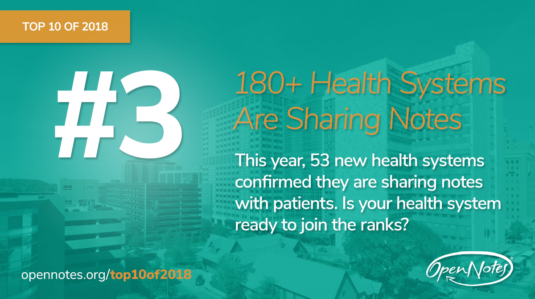 #3: More than 180 health systems are sharing notes
#3: More than 180 health systems are sharing notes
In 2018, 53 new health systems confirmed they were sharing notes bringing our total of OpenNotes health systems to 184. If your health system is sharing notes, and you’re not on our map, stand up and be counted! Complete this short survey, and add your name to the list of health systems who are changing the game for patients.
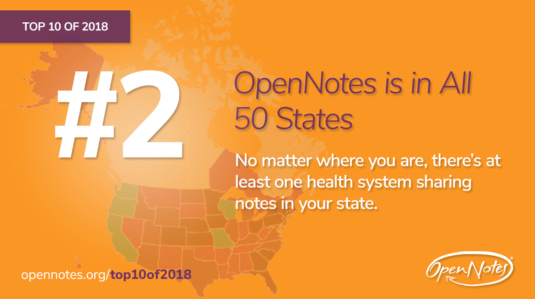 #2: OpenNotes is in all 50 states
#2: OpenNotes is in all 50 states
OpenNotes is now in all 50 states! No matter where you are in the US, there’s at least one health system in your state that shares notes with patients on their portal. California tops the OpenNotes leaderboard with 27 health systems sharing notes, followed by Washington (18) and Oregon (16). Check out our map to see who’s sharing in your state.
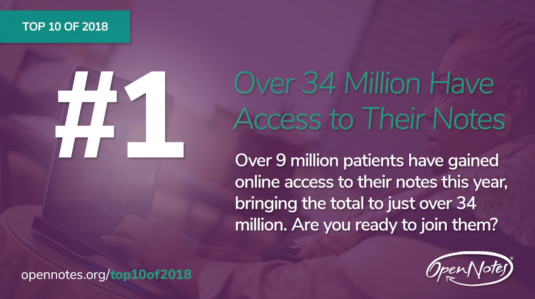 #1: Over 34 million have access to their notes
#1: Over 34 million have access to their notes
In 2018, more than 9 million patients gained access to their notes online, bringing the number of patients with access to notes to over 34 million. If you don’t have access to your notes online, ask your doctor to share them, get involved with your Patient and Family Advisory Council and make sure it’s a priority at your health system. Help us reach our goal of getting 50 million patients access to their notes by next year. Visit our Movement Hub to find out more.




You must be logged in to post a comment.